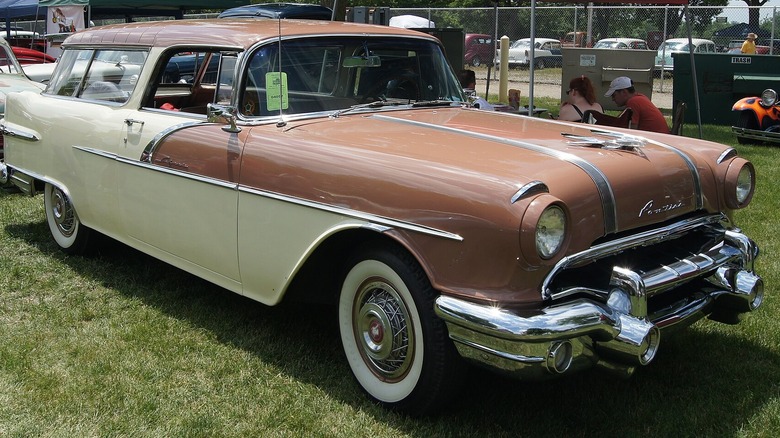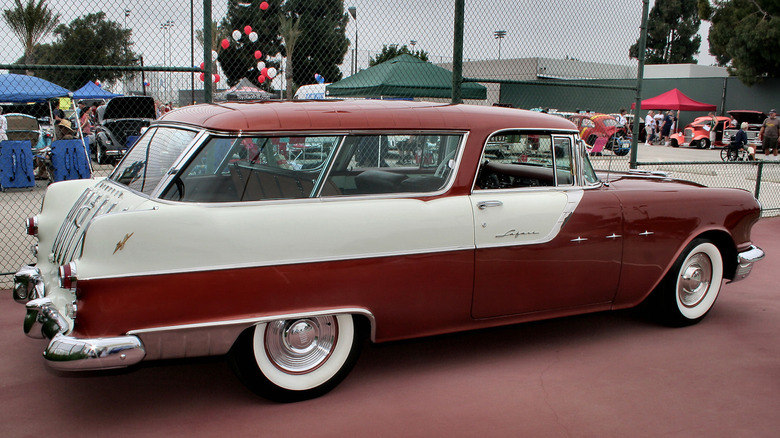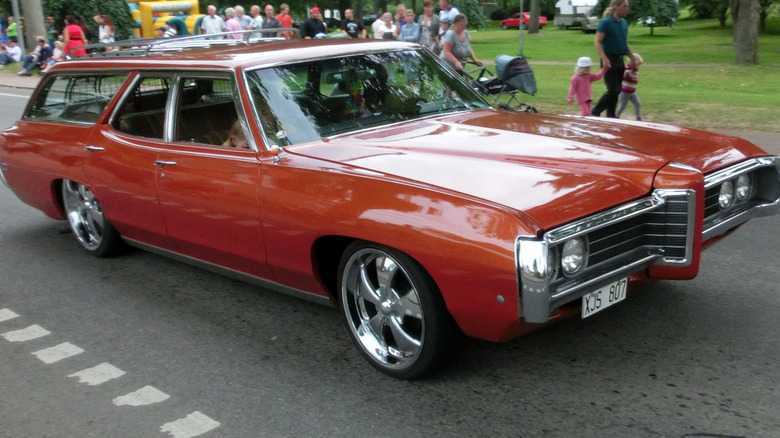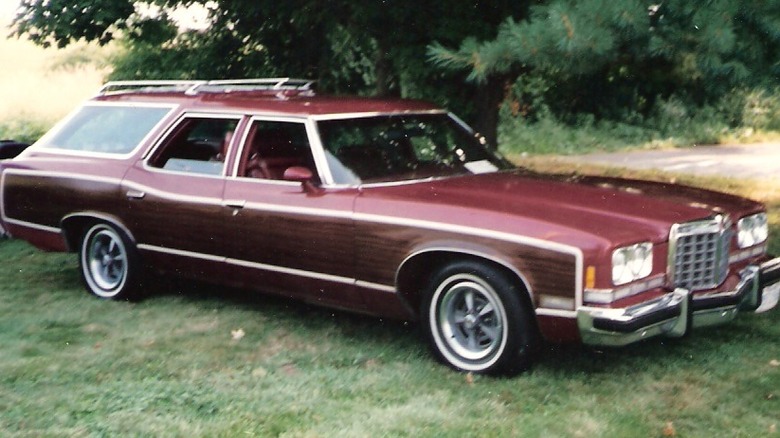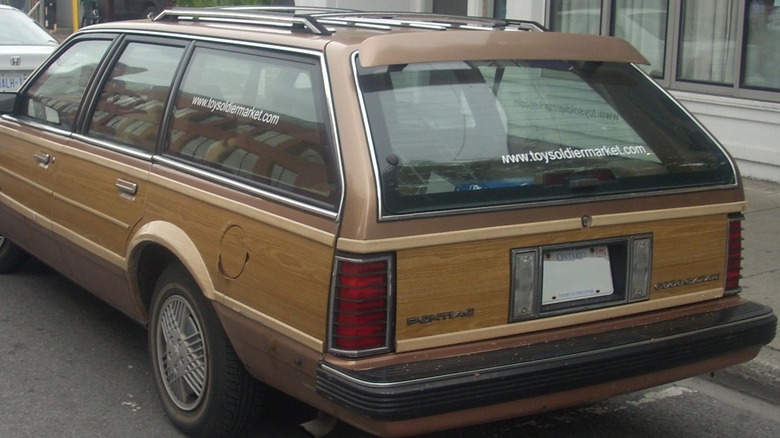4 Forgotten Pontiac Station Wagons You Might Not Know Existed
General Motors founded Pontiac in 1926 as an alternative to the existing Oakland brand. Ironically, it was overlap with Chevrolet and GM's bankruptcy proceedings that led to Pontiac's demise in 2009. In the meantime, Pontiac started the muscle car era with the 1964 GTO, brought us the mid-engine Fiero in the 1980s, and built the futuristic Aztec near the turn of the millennium. One thing Pontiac was not famous for was its station wagons. They didn't have the Fiero's tendency to catch fire, but Pontiac also never innovated in a big way with its wagons.
Instead of thinking outside the box, Pontiac played with the box a little. It sometimes made the box bigger, too — its 1970s station wagons were some of the longest and heaviest Pontiacs ever made. Later, Pontiac helped kill the station wagon with the Trans Sport minivan and the Aztec, which was sort of an early crossover SUV. Before that happened, though, Pontiac station wagons were part of family life, carrying up to nine people at a time. Here are a few Pontiac station wagons that don't enjoy the notoriety of the GTO or Fiero.
Safari (1955-1959)
Pontiac introduced the Star Chief Safari to its stable of station wagons along with its first overhead valve V8 in 1955. From 1955 though 1957, the company offered three four-door and a pair of two-door station wagons. While the U.S. has since seen domestic manufacturers replace station wagons with SUVs and mini-vans, Pontiac's mid- to late-'50s station wagons appeared in a place not commonly associated with this type of car: the drag strip.
In an age when poor weight distribution kept power from being transferred to the back wheels of some sedans and coupes, a station wagon offered a better-balanced option for those playing with Pontiac's new OHV V-8s. Off the lot, the Star Chief Safari was not one of the fastest station wagons ever built, but it could go from 0-60 mph in under 9 seconds. Just keep it going straight — Pontiac's cars lagged in handling ability until 1958, when ball joints replaced king pins in the front suspension and the control arms were redesigned.
Executive Safari (1967-1970)
Pontiac's Catalina and Bonneville lines spanned decades, and the Star Chief series lasted from 1954 though 1966. Along with these long-lasting models came the Executive, and with it the Executive Safari wagon. Though it lasted only four model years, the Executive was very much a typical Pontiac of its era. It started out in 1967 as the Star Chief Executive and brought Catalina-level options to the larger Bonneville platform. At the same time, certain restrictions were placed on the station wagons. As a result, while the 428 cubic inch engine was available for the Executive Safari, the high-output version was not.
The horsepower missing from the 428 HO was not what kept these station wagons off the strip. Pontiac began to phase out full-sized cars on the track as the 1960s progressed. The difference came down to performance cars getting smaller and lighter, while the luxury cars got heavier. For example, the heaviest Pontiac Bonneville station wagon in 1960 had a curb weight of 4,544 lbs compared to the Catalina Sport Sedan at 4,019 lbs with the same engine, and a 2-row 1969 Executive Safari weighed in at 4,658 lbs vs. the base GTO's 3,672 lbs.
Grand Safari (1971-1978)
One of the biggest and heaviest cars that Pontiac ever built was its Grand Safari station wagon from the 1970s. These cars were built on GM's 127-inch C-body platform, were over 19 feet long, and weighed 5,000 lbs early in the decade. A 455 cubic inch V8 was available to deliver a claimed 325 hp for 1971 in addition to the 400 cubic inch engine option producing 300 hp.
Pontiac's innovative streak — as far as the Grand Safari was concerned — was limited mostly to its tail end. The glass upper half of the tailgate slid up into the roof of the car, while the bottom hinged downward. The idea never caught on with the buying public, and this arrangement lasted from 1971 through 1976. When the second-generation Grand Safari came out in 1977, it had a three-way tailgate like its competitors'. This version was a more manageable 214 inches long and weighed almost a half ton less than its predecessor.
6000 Safari (1981-1991)
Even though its time in the 1980s is called the 'Malaise Era' of American auto manufacturing, the Pontiac 6000 should be remembered more fondly as an American response to Europe's better sedans. Pontiac introduced the station wagon version of the 6000 for the 1984 model year after the full sized Bonneville Safari was dropped. Though it was smaller than its predecessor, the 6000 Safari had a third rear-facing row that seated two, and the car could carry up to eight people. With the back seat down, the 6000 Safari had 74.4 cubic feet of hauling space.
The 6000 STE gained all the headlines and accolades, but the station wagon was well-received by those who were interested in a more practical hauler. The 6000 station wagon didn't share the STE's best features until late in the series' life, though. By 1990 and 1991, the 6000 SE Safari used the same 140-horsepower, 3.1-liter V6 as the STE. Unlike its sedan counterpart, though, the Pontiac 6000 station wagon was never issued in all-wheel drive.
